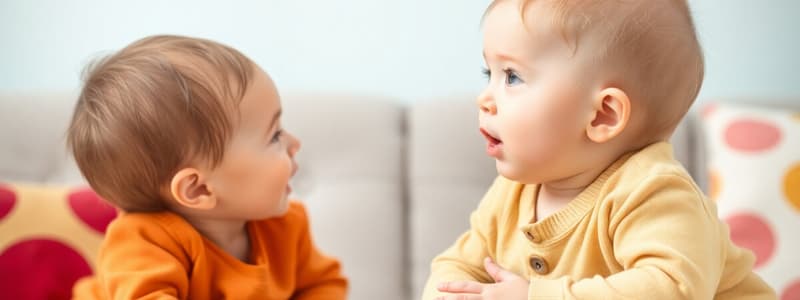Podcast
Questions and Answers
What does longer looking time in infants indicate during observation?
What does longer looking time in infants indicate during observation?
- Inability to focus on the stimulus
- Confusion about the stimulus
- More preference for the stimulus (correct)
- Less interest in the stimulus
What is the purpose of the habituation technique in studying infants?
What is the purpose of the habituation technique in studying infants?
- To encourage more active participation
- To help infants become accustomed to stimuli (correct)
- To assess cognitive abilities
- To increase the complexity of the stimuli
During which age range does the critical period for language development occur?
During which age range does the critical period for language development occur?
- 2-13 years (correct)
- 3-10 years
- 0-2 years
- 0-5 years
What characterizes speech known as parentese or baby talk?
What characterizes speech known as parentese or baby talk?
What type of language ability is referred to as receptive language?
What type of language ability is referred to as receptive language?
Which brain area is associated with speech comprehension?
Which brain area is associated with speech comprehension?
What does expressive language refer to in terms of communication?
What does expressive language refer to in terms of communication?
What is the first stage in Piaget’s Stage Theory of Cognitive Development?
What is the first stage in Piaget’s Stage Theory of Cognitive Development?
What is the critical period for visual activity development?
What is the critical period for visual activity development?
What does the process of neural pruning involve?
What does the process of neural pruning involve?
At what age do most infants typically begin to sit without support?
At what age do most infants typically begin to sit without support?
What is an example of a newborn reflex?
What is an example of a newborn reflex?
Which motor milestone is typically achieved last?
Which motor milestone is typically achieved last?
What does the preferential looking technique assess?
What does the preferential looking technique assess?
At what age do infants typically start to crawl?
At what age do infants typically start to crawl?
Which of the following is NOT a motor milestone listed for infants?
Which of the following is NOT a motor milestone listed for infants?
What is the primary function of the False Belief Task in child development?
What is the primary function of the False Belief Task in child development?
At what age does the development of the self-concept typically begin?
At what age does the development of the self-concept typically begin?
What significant change occurs in adolescence regarding social dynamics?
What significant change occurs in adolescence regarding social dynamics?
How does the perception of time change as people age?
How does the perception of time change as people age?
What elements typically comprise a person's self-concept?
What elements typically comprise a person's self-concept?
At what age does object permanence typically develop?
At what age does object permanence typically develop?
In which stage do children primarily think symbolically yet still lack logical reasoning?
In which stage do children primarily think symbolically yet still lack logical reasoning?
What developmental ability is primarily demonstrated by the A-not-B problem?
What developmental ability is primarily demonstrated by the A-not-B problem?
Which cognitive skill involves recognizing that different people can have varying feelings and beliefs?
Which cognitive skill involves recognizing that different people can have varying feelings and beliefs?
What characteristic is NOT a feature of the concrete operational stage?
What characteristic is NOT a feature of the concrete operational stage?
Which stage of development is marked by the ability to perform operations that can be undone?
Which stage of development is marked by the ability to perform operations that can be undone?
At which stage can children engage in hypothesis testing?
At which stage can children engage in hypothesis testing?
What does the conservation of quantity refer to in cognitive development?
What does the conservation of quantity refer to in cognitive development?
What aspect of personality does neuroticism primarily relate to?
What aspect of personality does neuroticism primarily relate to?
In the study by De La Mare and Lee, which traits did participants show a preference for similarity?
In the study by De La Mare and Lee, which traits did participants show a preference for similarity?
What is the primary purpose of the Minnesota Multiphasic Personality Inventory 2-RF?
What is the primary purpose of the Minnesota Multiphasic Personality Inventory 2-RF?
What is a characteristic feature of projective tests in personality assessment?
What is a characteristic feature of projective tests in personality assessment?
Which test uses unstructured inkblots to evaluate emotional responses?
Which test uses unstructured inkblots to evaluate emotional responses?
Which of the following statements about similarity-attraction effect is true?
Which of the following statements about similarity-attraction effect is true?
Which of these Big Five traits did participants show a general preference for in partners?
Which of these Big Five traits did participants show a general preference for in partners?
What is one major application of the Thematic Apperception Test?
What is one major application of the Thematic Apperception Test?
Flashcards are hidden until you start studying
Study Notes
Infant Development
- Examining an infant’s eye movements reveals what they focus on (longer looking time = more preference)
- Habituation technique involves repeatedly presenting stimuli until the infant becomes accustomed to them and pays less attention
- Language development critical period (2-13 years)
- Parentese (baby talk): characterized by higher pitch, slower speech, and over-annunciation, used when talking to babies and children, babies show preference for parentese
Language Development
- Receptive language: ability to understand language (follow instructions, answer comprehension questions)
- Wernicke’s area: brain area in left temporal lobe responsible for speech comprehension
- Expressive language: ability to express wants and needs through language (asking for something you want)
- Broca’s area: brain area in left frontal lobe responsible for speech production and articulation
- Theory of mind: ability to recognize that other people might have different feelings, beliefs, and experiences than we do, develops around 3-4 years of age
- False Belief Task: Tests a child's ability to understand that another person can have a different belief or perspective than their own, the child is asked to attribute a “false belief” to a character based on their limited knowledge
Cognitive Development
- Critical period: timeframe during which an organism must be exposed to specific stimuli for normal development to occur
- Neural pruning: the process by which the brain removes unnecessary connections between neurons, or brain cells
- Newborn reflexes: innate involuntary muscle response to stimulation (replaced over time with voluntary movements)
Motor Milestones
- Raise head from ground (0-2 months)
- Roll from back to front (3-5 months)
- Sit with support (4-6 months)
- Sit without support (6-8 months)
- Stand holding something (7-12 months)
- Crawl (7-10 months)
- Pull to stand/cruise (9-12 months)
- Walk with support (10-12 months)
- Walk alone (12 months +)
Visual Development and Critical Period
- Visual activity and the critical period: ability to distinguish between shapes, patterns and colours
- Critical period: birth-7 years old
- Preferential looking technique: used to assess visual acuity in infants and young children who are unable to identify pictures or letters, based on the idea that infants prefer to look at novel stimuli over familiar ones
Piaget’s Stage Theory of Cognitive Development
- Sensorimotor Stage (0-2 years): infants learn through their senses and motor skills
- Object permanence: understanding that objects exist even when not seen, develops by 9 months
- A-not-B problem: children search for a hidden toy in the same place it was originally hidden, even after watching it get hidden in a new location
- Preoperational Stage (2-7 years): children begin to think symbolically but continue to reason intuitively, without logic
- Conservation of quantity: knowing that a quantity doesn't change if its appearance has been altered
- Egocentrism: difficulty taking another’s viewpoint
- Concrete Operational Stage (7-12 years): children think logically about real (concrete) objects
- Formal Operational Stage (12+ years): ability to think critically and reason about abstract ideas
Adolescence
- What changes in adolescence?: greater reliance on peers for sense of belonging and acceptance
Adulthood
- As people age, they view time as limited and shift focus to meaningful events, experiences, and goals
Personality
- Neuroticism: poor emotional stability, greater reactivity
- Similarity-Attraction Effect : People like those similar to themselves
- De La Mare and Lee: IV = traits portrayed in dating profiles (Big Five), DV = interest in partners with similar traits (matching vs. swiping left)
- Results from De La Mare and Lee: matched on agreeableness, openness to experience, and extraversion, all P’s preferred low neuroticism
- Minnesota Multiphasic Personality Inventory 2-RF: 338 T/F questions, most commonly used in clinical settings, assesses antisocial personality, anxiety, depression, interpersonal problems
- Projective tests: personality test in which subjects are shown ambiguous images and asked to interpret them
- Rorschach Ink Blot Test: personality determined based on response to unstructured inkblots
- Thematic Apperception Test: a psychological assessment tool used to evaluate individuals' emotional responses and inner thoughts by analyzing their interpretations of ambiguous pictures
Studying That Suits You
Use AI to generate personalized quizzes and flashcards to suit your learning preferences.




